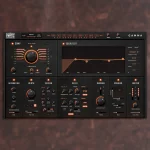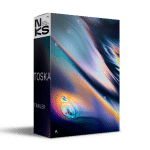Cinematic Studio Series Cinematic Studio Strings v1.7 KONTAKT Fix Update ONLY A powerful strings sample library for Kontakt Player
A powerful strings sample library for Kontakt Player
Cinematic Studio Strings is a library bursting with character. Featuring Australia’s finest musicians and meticulously recorded in a world-class scoring stage, CSS boasts a gorgeous sound, stunning true-to-life dynamics and a wide variety of articulations. With an intuitive and efficient GUI, CSS was created to meet the demands of working composers in today’s film, TV and video game industries. This outstanding orchestral strings library for Kontakt and Kontakt Player is available now at a very affordable price.
INTRODUCING CINEMATIC STUDIO STRINGS
CSS features a Hollywood-style string section, recorded in position in Australia’s premiere scoring stage – Trackdown. From the soaring colourful vibrato of the high violins to the dark and woody textures of the low cello and bass notes, you’ll be instantly inspired. Our aim was to create an instrument that’s instantly playable, sounds great out-of-the-box and is backed up by speedy customer support.
GROUNDBREAKING INTERFACE
At the heart of CSS is its cutting edge GUI, building on our previous critically-acclaimed library Cinematic Strings 2. This means a short-but-sweet patch list, easily assignable keyswitches and MIDI CCs, and a full mixer with output routing options plus reverb. These features and many others are all accessible via the main GUI page, you’ll have CSS working alongside you on your latest project within minutes.
REALISTIC AND EXPRESSIVE
CSS features a stunningly realistic legato engine. We painstakingly recorded true legato transitions for each note, up and down, including a beautiful portamento. We also recorded ‘re-bow’ samples, meaning you can play repeated legato notes smoothly and with true-legato realism. For more information please check out the Legato Introduction video in the Videos section below.
LIVE SOUND, NO REVERB REQUIRED
With smooth legato, punchy spiccatos, inspiring textural harmonics and con sordino, CSS covers a wide range of the sound palette afforded by a world-class string section. We’ve kept an authentic, human element in the sound, so you’ll feel like you’re at a live session. With this new level of realism, you’ll feel comfortable using CSS without reverb; in fact, we recommend it! All of our demos were created without reverb – all you hear is the natural air captured in the samples.
FULLY MIXED – LOAD AND PLAY
We used a variety of beautiful ribbon and condenser microphones to record CSS at three distances, which you can combine to create your own unique mix either inside Kontakt or via the newly included output-routing option. Alternatively, you can use our pre-mixed combination of all 3 if you want a great sound with fewer resources. Full and Lite Ensemble patches optimise workflow and are perfect for sketching or filling out a track.
Articulations:
– LEGATO, INCLUDING LEGATO REPETITION AND PORTAMENTO
– SPICCATO
– STACCATISSIMO
– STACCATO
– SFORZANDO
– PIZZICATO, INCLUDING BARTÓK SNAPS
– COL LEGNO
– HARMONICS
– TREMOLO
– TRILLS (HALF AND WHOLE TONE)
– MEASURED TREMOLO (TREMOLO SYNC AND FREE SYNC)
– MARCATO/FAST RUNS
– CON SORDINO EMULATION (WHOLE LIBRARY)
New Marcato mode (including runs)
The new improved “Marcato” articulation in CSS v1.7 is quite powerful. Its main purpose is to perform fast, energetic passages, ostinatos and runs. The vibrato is exaggerated, and the attack is accented, which means it excels at bombastic melodies, like the Star Wars theme for example.
However, since the legatos have been improved, it is also quite capable of playing less- accented, more varied phrases too – think of the violin parts early in the “Journey to the Island” cue from Jurassic Park. This is aided by the fact that you can also now trigger subtle portamento slides, so all in all, the new Marcato is a lot more versatile. I also added a 2 x round robin, which further enhances realism.
To play runs, simply play a fast passage in legato mode – it works especially well for scalic runs. You can add accents to individual notes within a run by triggering a note above a velocity of 75. This effect is subtle, but audible and useful in context, especially when you “change direction” during a run.
Alternatively, to create a more obvious accent, try leaving a gap between the previous note and the note you wish to accent, effectively starting a “new” legato phrase with the accented note. In other words, if you play a 10-note run, and would like to accent the 5th note in the phrase, you’ll need to leave a small gap between the 4th and 5th notes. This would effectively “end” the legato phrase at the end of the 4th note, and then “begin” a new legato phrase starting with the 5th note. This means you’ll hear the attack portion of the Marcato sample, which in the context of a fast passage, essentially functions as a more pronounced accent.
Improved legato / “Low Latency” mode
I spent a (very) long time re-editing all of the legato transition samples, not only to improve the timing, but also to ensure a more consistent volume envelope. This makes sequencing legato a breeze, and I also introduced a new “Low latency” mode, making it even easier to perform passages in real-time.
Low latency mode has a legato delay of approximately 150ms (but don’t hold me to it), and replaces the outgoing “Standard” legato mode, which had a delay of 250ms, while the new “Expressive” mode has replaced the outgoing “Advanced” mode. Expressive mode is very similar to the former Advanced mode, and is mainly just a name change, but it is still improved since the legato transitions themselves have been improved. Personally, I recommend using the low latency mode for most work, as I’ve found that it hits the sweet spot of realism and playability. However, Expressive mode still very much has its place, especially for slower, more pastoral thematic material. Experimenting with both modes will make it pretty clear as to which mode will work better for any given passage.
Re-edited, re-timed short notes / RR reset
The short notes in v1.7 are tighter and more consistent than they were previously. Similar to the re-timed legato transitions, these new short notes have also had their timing improved. This applies to all of the short note types in CSS – both bowed and plucked.
We have also implemented a “round robin reset” function, which can be accessed via CC59. Setting this CC to a specific value (eg 4) prior to the start of a short note passage will ensure that the same RR sequence plays out every time you play that passage. You won’t need to use this most of the time, as any random RR sequence should always sound perfectly fine in any given passage. Yet, having said that, there are certainly times when it is preferable for a sequence to sound exactly the same every time you play it (or export / render your piece), and that’s when this function comes in handy.
Improved mix / Separated spot mics
Improving the sound of CSS was another important aspect of the new version. My aim was to bring out more of the room-depth, as I felt this wasn’t as prominent in the previous mix. This means the new mix is more “roomy”, yet at the same time there’s also more clarity and detail in the close mics. So it’s the best of both worlds, really. This will become more obvious when applied in the brass library update, but for now the strings sound wider and more lush.
I also separated the spot mics so they are both now independently controllable, instead of being mixed together as they were in the previous version. This means you can effectively narrow or widen the sound of each section by playing around with the panning, or you can even do more extreme things like panning them hard left and right, which may be perfect for a pop-style arrangement / mix.
Spot 1 is focussed mainly on the two lead players of each section, and Spot 2 is positioned further back in the section and capturing more players. They each have their own distinct character, and I encourage you to experiment with the mixing of the spot mics – a lot can be done to customise the sound to your own tastes.
Note: The default positions for all of the volume and panning sliders reflect the exact settings used to create the Mix mic. This serves as a good starting point, and if you ever want to return to these default settings, you can hold Command + Option (Mac) or Control + Alt (Windows) and then click anywhere on any of the faders (or panning sliders), and they will all snap back to the default settings.
Better, more realistic non-vibrato legato transitions, and refined x-fading between them
Lastly, I have also improved the non-vibrato legato transitions. In the previous version of CSS I’d used simulated legato transitions, and while I didn’t record any new material for Version 1.7, I developed a technique to significantly improve the sound of these simulated transitions by editing the with-vibrato samples to create an all-new set of non-vibrato legato transitions.
This not only sounds more realistic, but also makes the x-fade system more straightforward and streamlined. By default, both the non-vibrato and with-vibrato samples are always triggered whenever you’re using the Sustain articulation. This means you can x-fade seamlessly between them at any time. However, it also means that the voice count is roughly twice what it was before, but I figured that most average systems could handle this pretty easily these days. Alternatively, if you’d prefer to disable this option, you can click on the config cog up in the top right corner, click on “Vibrato X- fade”, then scroll up to the top of the list and select “Off.” Doing this will mean that vibrato is set to maximum and is no longer controllable.
Homepage:-https://cinematicstudioseries.com/strings/






































